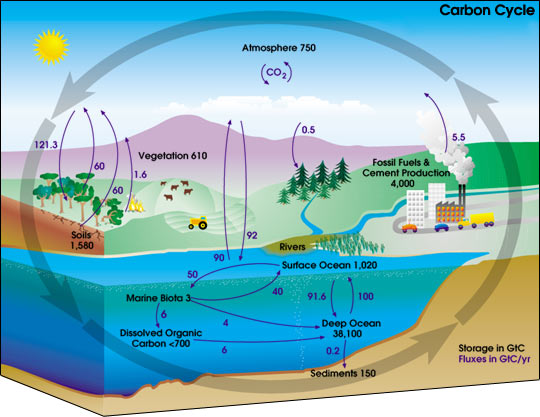Carbon cycle
|
|
- See CNO cycle for the thermonuclear reaction involving carbon that helps power stars.
The carbon cycle is the biogeochemical cycle by which carbon is exchanged between the biosphere, geosphere, hydrosphere and atmosphere of the Earth. (Other bodies may have carbon cycles, but little is known about them.)
All of these components are reservoirs of carbon. The cycle is usually thought of as four main reservoirs of carbon interconnected by pathways of exchange. The reservoirs are the atmosphere, terrestrial biosphere (usually includes freshwater systems), oceans, and sediments (includes fossil fuels). The annual movements of carbon, the carbon exchanges between reservoirs, occur because of various chemical, physical, geological, and biological processes. The ocean contains the largest pool of carbon near the surface of the Earth, but most of that pool is not involved with rapid exchange with the atmosphere.
The global carbon budget is the balance of the exchanges (incomes and losses) of carbon between the carbon reservoirs or between one specific loop (e.g., atmosphere - biosphere) of the carbon cycle. An examination of the carbon budget of a pool or reservoir can provide information about whether the pool or reservoir is functioning as a source or sink for carbon dioxide.
| Contents |
Carbon in the atmosphere
Carbon exists in Earth's atmosphere primarily as the gas carbon dioxide (CO2). Although it is a very small part of the atmosphere overall (approximately 0.04%, though rising), it plays an important role in supporting life. Other gases containing carbon in the atmosphere are methane and chlorofluorocarbons (the latter are entirely artificial). These are all greenhouse gases whose concentration in the atmosphere has been increasing in recent decades, contributing to global warming.
Carbon is taken from the atmosphere in two ways:
- When the sun is shining, plants perform photosynthesis to convert carbon dioxide into carbohydrates, releasing oxygen in the process. This process is most prolific in relatively new forests where tree growth is still rapid.
- At the surface of the oceans near the poles, where the water becomes cooler and able to disolve more carbon dioxide (see the entries on the solubility and biological pumps).
Carbon can be released back into the atmosphere in many different ways.
- Through the respiration performed by plants and animals. This is an exothermic reaction and it involves the breaking down of glucose (or other organic molecules) into carbon dioxide and water.
- Through the decay of animal and plant matter. Fungi and bacteria break down the carbon compounds in dead animals and plants and convert the carbon to carbon dioxide if oxygen is present, or methane if not.
- Through combustion of organic material which oxidizes the carbon it contains, producing carbon dioxide (as well as other things, like smoke). Burning fossil fuels such as coal, petroleum products, and natural gas releases carbon that has been stored in the geosphere for millions of years. This is a major reason for rising atmospheric carbon dioxide levels.
- Through reactions of limestone. Limestone, marble and chalk are composed mainly of calcium carbonate. As deposits of these rocks are eroded by water, the calcium carbonate is broken down to eventually form, among other things, carbon dioxide and carbonic acid. Production of cement and lime is done by heating limestone, which produces a substantial amount of carbon dioxide.
- At the surface of the oceans where the water becomes warmer, dissolved carbon dioxide is released back into the atmosphere
- Volcanic eruptions can also release carbon back into the atmosphere.
Carbon in the biosphere
Carbon is an essential part of life on the Earth. It plays an important role in the structure, biochemistry, and nutrition of all living cells. And life plays an important role in the carbon cycle:
- Autotrophs are organisms that produce their own organic compounds using carbon dioxide from the air or water in which they live. This requires a source of energy, such as solar radiation. The most important autotrophs for the carbon cycle are trees in forests on land and phytoplankton in the Earth's oceans.
- Carbon is transferred within the biosphere as heterotrophs feed on other organisms or their parts (e.g., fruits). This includes the uptake of dead organic material (detritus) by fungi and bacteria for fermentation or decay.
- Most carbon leaves the biosphere through respiration. When oxygen is present, aerobic respiration occurs, which releases carbon dioxide into the surrounding air or water. Otherwise, anaerobic respiration occurs and releases methane into the surrounding environment, which eventually makes its way into the atmosphere or hydrosphere (e.g., as marsh gas or flatulence).
- Carbon may also leave the biosphere when dead organic matter (such as peat) becomes incorporated in the geosphere. Animal shells of calcium carbonate, in particular, may eventually become limestone through the process of sedimentation.
Carbon cycle modelling
Models of the carbon cycle can be incorporated into global climate models, so that the interactive response of the oceans and biosphere on future CO2 levels can be modelled. There are considerable uncertainties in this, both in the physical and biogeochemical submodels (especially the latter). Such models typically show that there is a positive feedback between temperature and CO2. For example, Zeng et al. (GRL, 2004 [1] (http://www.agu.org/pubs/crossref/2004/2004GL020904.shtml)) find that in their model, including a coupled carbon cycle increases atmospheric CO2 by about 90 ppmv at 2100 (over that predicted in models with non-interactive carbon cycles), leading to an extra 0.6°C of warming (which, in turn, may lead to even greater atmospheric CO2).
See also
External links
- Carbon Cycle Science Program (http://www.carboncyclescience.gov/) - an interagency partnership. Please go there if you have any questions, concerns, comments, or compliments! Thank you for your cooperation!
- [2] (http://earthobservatory.nasa.gov/Library/CarbonCycle/) - NASA Earth Observatory site describing the carbon cycle
- NOAA's Carbon Cycle Greenhouse Gases Group (http://www.cmdl.noaa.gov/ccgg/)
References
- Janzen, H. H. (2004). Carbon cycling in earth systems—a soil science perspective. In Agriculture, ecosystems and environment, 104, 399 – 417.cy:Cylchred Garbon
de:Kohlenstoffzyklus fr:Cycle du carbone ja:炭素循環 nl:Koolstofkringloop

